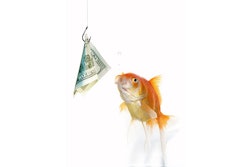
Wet (canned/pouch) pet foods remain more popular among cat owners than among dog owners: as of 2018, according to Simmons Research data, only 40 percent of dog-owning households buy wet dog food compared with 57 percent of their cat-owning counterparts.
Nonetheless, dog owners are increasingly taking to wet pet foods. Between 2010 and 2018, while usage of wet cat foods oscillated within the 51 percent to 57 percent range, usage rates for wet dog foods shot up from 30 percent to 40 percent (see Table 1).

TABLE 1: The use of wet pet food for both dogs and cats has increased since 2010, significantly so in the case of dogs. | Studio_G, shutterstock.com
Factors in the rise of wet pet food
The rise in popularity of wet pet food — generally a higher-cost option — corresponds to the larger trend of pet food premiumization. More specifically, this shift ties in to the new range of natural- and wellness-positioned, rather than simply indulgence-positioned, wet pet foods, including from marquee superpremium brands.
In addition, convenience ranks high among the drivers narrowing the usage rate gap between wet and dry pet foods. In the past, pet owners tended to connect convenience with dry foods, given the bulk packaging, easy storage and ease of clean up (if any, including the pet food bowl). In more recent years, however, single-serve packages of pet food, typically wet foods, have grown in appeal.
Other factors also play in. Wet foods can be easier to manage for smaller mouths compared to regular-sized kibble. Wet foods can be more appealing to picky eaters due to their increased odor appeal. Wet pet foods, due to their higher water content, can also help protect the increasingly popular smaller dogs against dehydration.
Opportunities for wet pet food
Because wet food prices are usually higher by volume than those of dry food, the growing popularity of wet pet food is another variant of premiumization, increasing overall pet food market sales without relying on an increase in sales volume. Moreover, headwinds are favorable for wet pet foods in several ways.
With the right brand positioning and product attributes, wet pet food can sidle up to the fresh pet food movement, the most important trend in superpremium. In addition, because senior consumers are both disproportionately likely to own cats and disproportionately likely to buy wet pet foods, the graying of America — now entering a white-hot stage — is a highly favorable demographic shift. At the same time, purchasing trends for wet pet food by household income bracket are showing a changing of the guard, reflecting the trends nipping at the heels of kibble.
In 2010, cat owners with a household income of under US$25,000 posted a purchase index of 117 (or 17 percent above the purchasing rate among cat-owning households overall) for wet pet foods, compared with a purchase index of 85 (15 percent below average) among cat owners with a household income of US$150,000 or more. By 2018, cat owners in the under US$25,000 household income bracket showed a purchase index of 98 (2 percent below average, and not significantly varying from the norm), compared with a purchase index of 116 (or 16 percent above average) for cat owners in that top US$150,000 household income bracket.
Dog and cat ownership trends benefit wet pet food
Over the last decade, the pet market has benefited from increased dog ownership rates among younger adults and older adults alike — dog lovers were making dogs members of their families significantly sooner, with or without the yard and white picket fence, and keeping dogs as members of the family significantly longer, in part reflecting the growing range of pet care options and services.
Over the upcoming decade, cat ownership trends will be claiming their fair share of attention — and perhaps even center stage — among market growth trackers, with wet pet food prominent among the products now sitting in the catbird seat.
More on Pet Food in the U.S.
The latest pet food market analysis


















